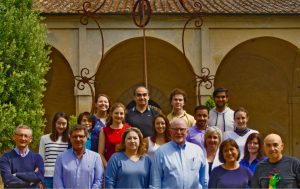I am a student on the doctoral training partnership funded by KCL and the MRC, and my project is based at the BRAIN centre. I will be utilising the many MRI modalities available at the preclinical centre to image the brains of healthy rats across their lifespan. I hope to find biomarkers which can predict who will experience cognitive decline. As our project start is imminent, I attended the Neuroscience School of Advanced Studies (before scanning fills my time).
Luigi Pulvirenti, the president and scientific director of NSAS, invites prominent investigators to coordinate advanced courses, which feature a faculty of speakers engaging with students and discussing challenges in their chosen field. Balancing the intense timetable with a relaxed setting has seen the school flourish beyond the initial cellular and molecular neuroscience themes offered when the course started three years ago, and now includes cognitive neuroscience courses. I attended the week-long course, “Cognitive decline and ageing”, coordinated by John H. Morrison of University of California, Davis in the beautiful setting of Certosa di Pontignano which is ~5km outside Siena, Italy.
Each day, one faculty member presented their unique perspective from 9 am to 1 pm and from 4.30pm to 7.30pm. The audience consisted of twelve students and the available faculty members, so sessions felt relaxed and tangential discussion was frequent. The background and career stage of the “students” were well-mixed: myself and another participant were PhD students, most were post-docs, and there were clinicians and independent researchers.
Mark Baxter from Icahn School of Medicine at Mount Sinai was due to present a broad introduction to the course, but he was unable to attend. Jennifer Bizon of University Florida gave a comprehensive overview of ageing, of the regions and circuits important for cognition – the medial temporal and pre-frontal lobes – and how they change across the lifespan in humans and animals through a series of analogous experiments in animal models and human studies. The next day, she gave her intended presentation on excitatory-inhibitory signalling dynamics across the lifespan, expanding her previous presentation by describing the difference between tasks which rely on the same region (e.g. working memory and cognitive flexibility both rely on the pre-frontal cortex, but need polar tasks: maintenance of information and rapid revision of information). This is due to the activity of selectively-tuned pyramidal neurons in the pre-frontal cortex, and the success of this neuronal firing might be key to describing individual differences in cognitive decline.
The importance of synaptic health during ages was elaborated in the following two days. Tara Spires-Jones from University of Edinburgh described her work to better understand how pathological proteins (which accumulate in healthy ageing and in disease) relate to synaptic degeneration. This was complemented by the presentation of non-human primate and rodent research. Particularly, ageing is related to loss of small dendritic spines, in both the prefrontal cortex and medial temporal lobe. This work is far from what I usually do; it takes place at a cellular and molecular level whereas I have been focusing on neuroimaging for the last few. Yet, in the relaxed atmosphere, I found the faculty approachable with my questions – both in the sessions and at other times.
The next two speakers provided a more familiar perspective (at least for me!), which focused on human neuroimaging research. Naftali Raz and Ulman Lindenberger, from Wayne State University and Max Planck Institute for Human Development respectively, both highlighted the need for a lifespan view of ageing and more longitudinal studies. Among the many reasons they gave, the most cogent is that ageing is a developmental process that is not a homogeneous. To put it simply, age-related brain changes happen at different times and rates for everyone. Individual differences in gross brain structure and function seem to provide a resilience to ageing phenotypes, and this echoed the previous message of looking at variability at a cellular level.
To wrap up the week, Roberta Brinton from University of Arizona addressed clinical treatment strategies and the importance of metabolic and hormonal fluctuations at critical life stages. She proposes that physiological ageing is not linear and that the largest changes associated with physiological ageing occur at transitional developmental stages, such as during puberty and during menopause. At these times, the brain is inherently unstable and thus could be a source of the observed individual variability. Furthermore, looking at sex differences in metabolism during key dynamic time points could provide an opportunity to better personalise interventions for neurodegenerative diseases that are best predicted by ageing.
I took away a few key points from this engaging and stimulating week. Firstly, we need to rethink how we think of ageing because, unlike chronological ageing, it is not linear but also it doesn’t suddenly happen. Physiological ageing is a life-long, dynamic process. It’s becoming clear that individual differences are as interesting as group differences. Currently, we are unable to perfectly predict who will suffer worse ageing outcomes than others, which is influential in our group definitions and recruitment may not be as precise as we think. It’s therefore important to fund more longitudinal studies to measure individual differences in ageing, which will give us a better understanding of the developmental progression. Nonetheless, integrative brain regions repeatedly seem to be most susceptible to ageing: the same brain areas, all of which receive various inputs from a diverse list of regions, were repeatedly declared as those most susceptible to ageing with evidence at many levels. These regions are more likely to see gross structural and functional changes, they are the first areas to accumulate pathological proteins, and they also have the highest metabolic costs. Finally, the concept of resilience and flexibility was applicable across brain levels, from synapses to whole brain networks. The story that appears portrays neuronal metabolic function somehow leaving highly associative regions more susceptible to the accumulation of pathological proteins and dendrite loss, which modifies brain structure and function on a network scale, before resulting in the behavioural changes associated with ageing.


